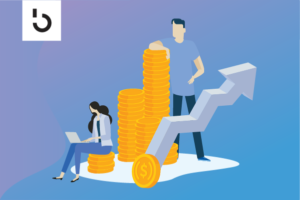
Happy days are here again: as I write this, bitcoin is back up over $35,000. ETH is surging above $2,000. The entire crypto market is up +76% year-over-year.
Which should be a reminder to all of us crypto investors: patience is a virtue.
Most crypto investors are not patient. I’m sure you know about the crypto “degens,” who are constantly chasing money-making schemes, no matter how ill-advised. Get rich quick, or die trying.
But the nature of investing means that patience pays off. (Literally.)
The author Morgan Housel, in his excellent book The Psychology of Money, devotes a whole chapter to the magic of compounding interest, pointing out that Warren Buffett made the vast majority of his fortune after the age of 50.
As of this writing, Buffett is 93 years old and worth about $118 billion, most of which accumulated well after middle age (courtesy of Finmasters):
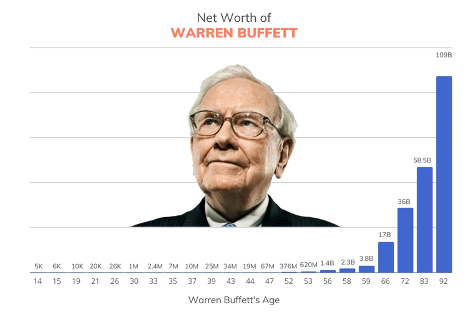
Housel points out that perhaps the most important factor to Buffett’s success is that he’s been investing since he was literally a child. “None of the 2,000 books picking apart Buffett’s success,” he says, “are titled This Guy Has Been Investing Consistently for Three-Quarters of a Century.”
“The most powerful and important [investing] book,” he suggests, “should be called Shut Up and Wait.”
Shut Up and Wait
Bitcoin’s fortunes have risen so high, in such a short period of time, that crypto investors are not used to waiting. (And we’re definitely not used to shutting up.)
As of this writing, bitcoin’s three-year returns are 23%. The five-year returns are 56%. The ten-year returns are about 60%.
(By comparison, the U.S. stock market has grown about 10% on average, over the long run.)
Of course, we don’t know what bitcoin will do next year, or even next week. But the point is, patience has paid off.
If you have been patient with many of your “old-school” crypto investments, you have been rewarded in recent weeks.
- Chainlink (LINK) is up 109% year-over-year, based on excitement around transferring real-world assets via its Cross-Chain Interoperability Protocol.
- Solana (SOL) is up 187% year-over-year, based on excitement around Visa, Shopify, and others building on its network.
- And of course, bitcoin (BTC) and Ethereum (ETH) are up 111% and 60% year-over-year, respectively, based on excitement about a spot ETF for both.
Slowly but surely, despite all the FUD and FOMO, despite the SEC and the CFTC, crypto is making inroads into the world of traditional finance.
Our patience is paying off.
Instead of screaming at every setback, the loudmouths on crypto Twitter would be better served to just heed those four simple words: SHUT UP AND WAIT.
The One-Month Millionaire
Take a penny and double it every day for 30 days. You’ll be a millionaire by Day 28, and you’ll have over $5 million on Day 30.
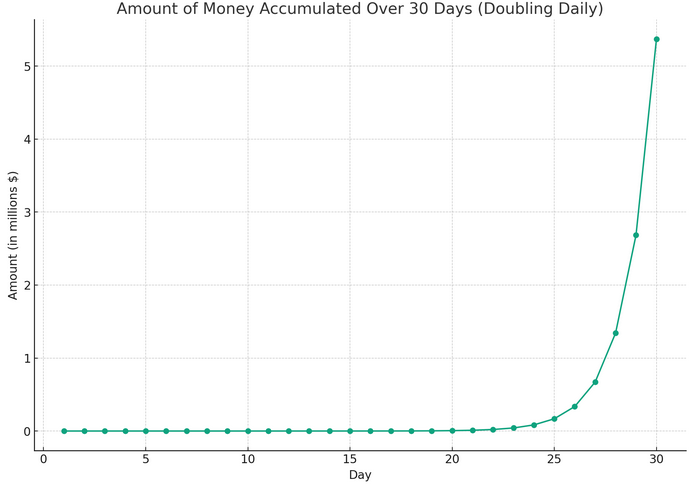
Many forms of growth happen the same way. Take compounding interest, which moves really slowly until it suddenly explodes. This is the principle behind putting aside, say, $100/month and putting it into a retirement plan. The longer you do it, the bigger your retirement nest egg:
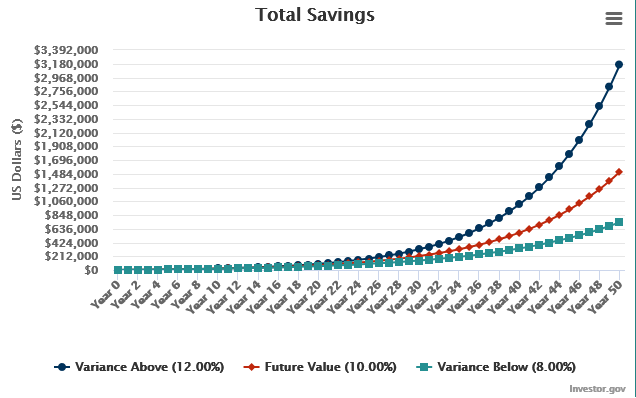
In crypto investing, there’s more to the story. Blockchains have network effects, which have a similar growth trajectory. Thanks to Metcalfe’s Law, as the number of users grows linearly, the number of connections grows quadratically:
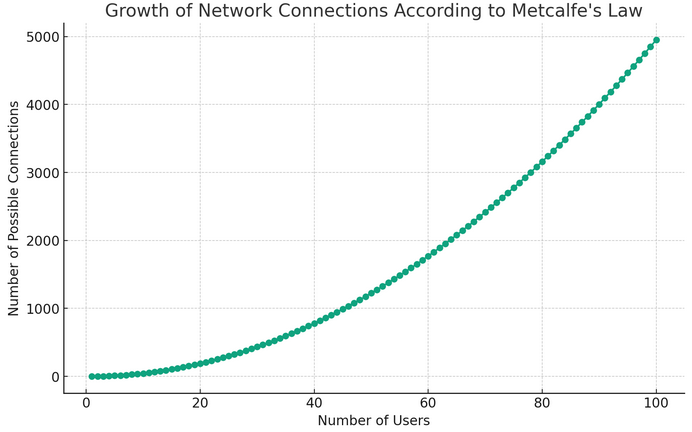
As blockchain investors, then, we can harness two powerful forces: both the network effects of good projects that are continually growing their userbase, and the compounding effects of these investments over time.
This is what’s happening today with COMP, SOL, BTC, and ETH. Through good times and bad, crypto summers and winters, they’ve continued to move forward, finding real-world use cases, building partnerships, and upgrading their technology.
There is one thing wrong with these charts, though: it’s not a straight shot.
There are many other factors at play: fear of the SEC, the FTX trial, interest rates, and so on. These make the trajectory look more like a roller coaster, even if the fundamental value should look more like the smooth charts above.
But if we stay the course, like Warren Buffett, eventually our net worth can show the same kind of hypergrowth as his has.
Our Approach
I’ll keep repeating our strategy, because it has worked so well for us.
- Buy BTC, plus a handful of quality crypto projects (the tokens above are good places to start);
- At the same time, each month, regardless of price;
- As a small part of a balanced portfolio (consider 60% stocks, 30% bonds, 10% crypto)
It’s hard to keep doing this when crypto is dropping, but it’s easy when crypto is popping.
That might make this the easiest time to get started. Those who started five years ago have greatly outperformed traditional investors:
In short: shut up and wait.
Want to get more insight on DeFi? Subscribe to Bitcoin Market Journal and get investing tips delivered straight to your inbox.
- SEO Powered Content & PR Distribution. Get Amplified Today.
- PlatoData.Network Vertical Generative Ai. Empower Yourself. Access Here.
- PlatoAiStream. Web3 Intelligence. Knowledge Amplified. Access Here.
- PlatoESG. Carbon, CleanTech, Energy, Environment, Solar, Waste Management. Access Here.
- PlatoHealth. Biotech and Clinical Trials Intelligence. Access Here.
- Source: https://www.bitcoinmarketjournal.com/how-warren-buffett-got-so-rich/
- :has
- :is
- :not
- $UP
- 000
- 100
- 28
- 30
- 50
- a
- About
- above
- According
- Accumulated
- After
- again
- age
- ago
- alarm
- All
- amount
- an
- and
- apart
- ARE
- around
- AS
- aside
- Assets
- At
- author
- average
- back
- Bad
- balanced
- based
- BE
- because
- been
- behind
- Better
- bigger
- Billion
- Bitcoin
- Bitcoin market
- blockchain
- blockchain investors
- blockchains
- Bonds
- book
- Books
- both
- BTC
- Building
- but
- by
- called
- CAN
- cases
- CFTC
- Chapter
- Charts
- child
- Clock
- Coindesk
- CoinGecko
- COMP
- comparison
- Compounding Interest
- Connections
- Consider
- consistently
- constantly
- continually
- continued
- course
- creates
- Cross-Chain
- crypto
- crypto investing
- crypto investments
- Crypto investors
- crypto projects
- day
- Days
- DeFi
- definitely
- delivered
- Despite
- Die
- do
- doing
- Dont
- double
- Dropping
- each
- easiest
- easy
- ETF
- ETH
- ethereum
- ethereum (ETH)
- Even
- eventually
- Every
- every day
- excellent
- Explodes
- factor
- factors
- fear
- finance
- finding
- five
- FOMO
- For
- Forces
- forms
- Fortune
- fortunes
- Forward
- four
- FTX
- FUD
- fundamental
- get
- good
- got
- greatly
- Growing
- grown
- Grows
- Growth
- Guy
- handful
- happen
- Happening
- Hard
- harness
- Have
- he
- here
- High
- his
- holding
- How
- HTTPS
- hypergrowth
- i
- if
- important
- in
- insight
- interest
- Interest Rates
- Interoperability
- into
- investing
- Investments
- Investors
- IT
- ITS
- jpg
- just
- Keep
- Kind
- Know
- Law
- like
- LINK
- Long
- longer
- Look
- made
- magic
- Majority
- make
- Making
- many
- Market
- Matter
- max-width
- means
- Metcalf
- Middle
- might
- million
- Millionaire
- money
- money-making
- Month
- more
- Morgan
- most
- move
- move forward
- moves
- Nature
- Nest
- net
- network
- next
- next week
- no
- number
- of
- off
- Old
- on
- ONE
- one-month
- or
- Other
- Others
- our
- out
- outperformed
- over
- paid
- part
- partnerships
- Patience
- patient
- paying
- pays
- perhaps
- period
- Places
- plan
- plato
- Plato Data Intelligence
- PlatoData
- Play
- plus
- Point
- points
- portfolio
- possible
- powerful
- price
- principle
- projects
- protocol
- Psychology
- Putting
- quality
- Quick
- Rates
- real world
- really
- recent
- Regardless
- reminder
- retirement
- returns
- Reuters
- rewarded
- Rich
- Risen
- Run
- s
- same
- Savings
- say
- says
- schemes
- screaming
- SEC
- served
- Shopify
- Short
- should
- show
- similar
- Simple
- since
- Slowly
- small
- smooth
- So
- SOL
- Spot
- spot etf
- start
- started
- stay
- stock
- stock market
- Stocks
- Story
- straight
- Strategy
- subscribe
- success
- such
- Suggests
- sure
- surely
- surging
- Take
- Technology
- thanks
- that
- The
- the world
- their
- then
- These
- thing
- this
- those
- though?
- Through
- time
- times
- tips
- titled
- to
- today
- Tokens
- Total
- traditional
- traditional finance
- trajectory
- Transferring
- trial
- trying
- two
- u.s.
- until
- us
- us crypto
- use
- used
- users
- value
- Vast
- via
- visa
- wait
- Waiting
- warren
- Warren Buffett
- was
- Way..
- we
- week
- Weeks
- WELL
- What
- when
- which
- WHO
- whole
- will
- with
- words
- worked
- world
- worth
- would
- write
- writing
- Wrong
- year
- years
- you
- Your
- zephyrnet








